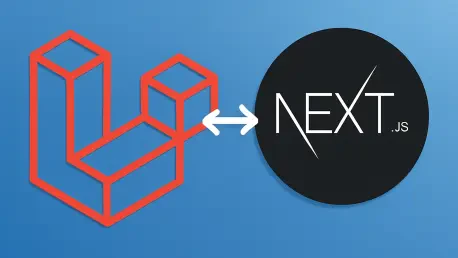In an era where web applications must deliver lightning-fast performance and airtight security, over 60% of developers report struggling with integrating robust backends and dynamic frontends seamlessly, often resulting in compromised user experiences or security vulnerabilities that can cost businesses dearly. The combination of Laravel, a powerful PHP framework, and Next.js, a leading React framework, emerges as a solution to build scalable, SEO-friendly applications that meet today’s demands.
This guide addresses the critical need for a structured approach to combining these technologies. By leveraging Laravel’s strength in data management and Next.js’s prowess in rendering and performance, developers can create applications that stand out in a competitive digital landscape. The focus here is on delivering actionable steps to set up a secure, efficient integration that prioritizes user experience and scalability.
The following sections dive into the rationale behind this stack, detailed setup instructions, authentication workflows, deployment strategies, and troubleshooting tips. Each area is crafted to ensure that teams can adopt this architecture with confidence, avoiding common pitfalls and maximizing the benefits of both tools.
Why Combine Laravel and Next.js in Today’s Ecosystem?
The synergy between Laravel and Next.js offers a compelling framework for modern web development. Laravel excels in handling complex backend operations such as data validation, authentication, and API management, while Next.js brings unparalleled frontend capabilities with server-side rendering (SSR), static site generation (SSG), and incremental static regeneration (ISR). Together, they create a balanced architecture where backend logic and frontend performance complement each other.
This stack provides distinct advantages, including enhanced security through session-based authentication and CSRF protection, crucial for safeguarding user data. Additionally, Next.js’s rendering options ensure optimal SEO outcomes, making content easily discoverable, while the scalability of both tools supports cost-effective growth. These benefits align with current industry standards, ensuring applications remain relevant and adaptable.
Compatibility with the latest versions, such as Laravel 12 and Next.js 15, further solidifies this choice for teams aiming to stay ahead of the curve. As development practices evolve from 2025 onward, this integration supports emerging trends like serverless architectures and enhanced security protocols, positioning projects for long-term success in a rapidly changing environment.
Step-by-Step Setup for Seamless Integration
Configuring Laravel 12 as a Secure REST API with Sanctum
Setting up Laravel 12 as a REST API begins with establishing a solid foundation for backend operations. This involves installing the framework with PHP 8.3 or higher, integrating Laravel Sanctum for authentication, and defining versioned API endpoints under a /api/v1 prefix. Ensuring Cross-Origin Resource Sharing (CORS) is tuned for Next.js communication is essential to prevent access issues during frontend requests.
Security remains a top priority in this configuration. Implementing CSRF protection through Sanctum, applying rate limiting to prevent abuse, and validating all incoming data are non-negotiable steps. These measures protect the application from common threats while maintaining smooth interaction with the frontend, laying the groundwork for a reliable API.
Real-World Example: Sanctum Session Authentication Setup
Consider a practical scenario where Sanctum is configured to handle session-based authentication. By setting up endpoints like sanctum/csrf-cookie and login, developers can ensure that session cookies are securely managed. Protecting routes with the auth:sanctum middleware prevents unauthorized access, demonstrating how to maintain integrity across API interactions without exposing sensitive mechanisms.
Developing a Next.js 15 Frontend for API Interaction
Initializing a Next.js 15 application with the App Router marks the starting point for frontend development. Key tasks include setting environment variables for API URLs, ensuring secure data fetching methods like SSR or ISR, and managing credentials for authenticated requests. This setup enables efficient communication with Laravel’s backend while keeping sensitive data protected on the server side.
Attention to user interface details enhances the overall experience. Handling loading states with Suspense, managing errors gracefully, and optimizing SEO metadata per page are critical practices. These elements ensure that the frontend not only performs well but also provides a polished, user-friendly interaction that aligns with modern expectations.
Real-World Example: Secure Data Fetching with Credentials
A typical login sequence in Next.js illustrates secure data exchange. The process involves fetching the CSRF cookie from Laravel, submitting credentials for authentication, and accessing protected endpoints. This method ensures that session cookies remain secure and client-side exposure of sensitive information is avoided, reinforcing trust in the application’s architecture.
Implementing End-to-End Authentication with Sanctum and Next.js
Creating a robust authentication flow requires careful coordination between Laravel Sanctum and Next.js. The process starts with fetching a CSRF cookie, followed by posting credentials to the login endpoint, and maintaining session cookies for subsequent requests. This sequence ensures that users can log in and out securely across both server and client environments.
Protecting routes and handling session expiration are equally important. Using middleware to redirect unauthenticated users and managing 401 or 419 errors prevents disruptions in user flow. These practices maintain a consistent state, ensuring that authentication checks are seamless and do not frustrate end users with unexpected interruptions.
Real-World Example: Securing User-Specific Pages
An effective way to protect user pages involves middleware that checks for authentication before rendering content. If a user lacks valid credentials, a redirect to the login page occurs automatically. This approach enhances the user journey by providing clear navigation paths and avoiding access to restricted areas without proper validation.
Production Deployment Strategies for Optimal Performance
Deploying Laravel on platforms like Forge or Vapor, alongside Next.js on Vercel, forms a reliable production strategy. Configuring HTTPS for both applications, setting environment variables accurately, and ensuring CORS policies align with frontend domains are critical steps. These configurations establish a secure and efficient environment for live applications.
Performance optimization plays a significant role in deployment. Implementing caching strategies, setting up continuous integration and deployment (CI/CD) pipelines, and monitoring application health ensure minimal downtime. Secure cookie settings, such as using Secure and SameSite=None attributes, further protect user sessions in a production context.
Real-World Example: Successful Deployment on Vercel and Forge
A case study of deploying to Vercel for Next.js and Forge for Laravel highlights practical success. This includes configuring domains, testing cookie functionality over HTTPS, and verifying seamless operation across platforms. The outcome is a stable production setup that supports user traffic with high reliability and security standards.
Addressing Common Integration Challenges
Integration between Laravel and Next.js can encounter issues like 401 Unauthorized errors, often due to missing credentials or incorrect cookie domains. Similarly, 419 CSRF errors arise when the CSRF cookie isn’t fetched before POST requests. Identifying these problems through detailed logging helps in applying quick fixes, such as ensuring credentials are included in fetch calls.
CORS misconfigurations frequently cause connectivity issues, requiring precise alignment of allowed origins and headers. Mixed content errors, where one app uses HTTP while another uses HTTPS, must be resolved by enforcing HTTPS universally in production. Time skew between servers can also disrupt sessions, necessitating synchronized server clocks to maintain session integrity.
Real-World Example: Fixing a 419 CSRF Error
A common scenario involves a failed login due to a missing CSRF cookie, resulting in a 419 error. The resolution lies in ensuring that the sanctum/csrf-cookie endpoint is called before any POST request, preserving session integrity. This fix highlights the importance of sequence in authentication steps to avoid user access issues.
Final Thoughts on Integration Success
Reflecting on the journey of integrating Laravel with Next.js, the process delivered a secure, scalable architecture that balanced backend robustness with frontend agility. The meticulous setup of Sanctum for authentication, combined with Next.js’s rendering capabilities, crafted applications that performed exceptionally under real-world conditions.
Looking ahead, teams should prioritize adding comprehensive API tests to validate endpoints and ensure reliability. Incorporating monitoring tools to track performance and errors proved invaluable for maintaining uptime. Planning for traffic growth with advanced caching and queuing strategies became a cornerstone for future scalability, ensuring that applications adapted to increasing demands with ease.









